FIAT CROMA 2006 2.G Owners Manual
Manufacturer: FIAT, Model Year: 2006, Model line: CROMA, Model: FIAT CROMA 2006 2.GPages: 240, PDF Size: 7.41 MB
Page 101 of 240
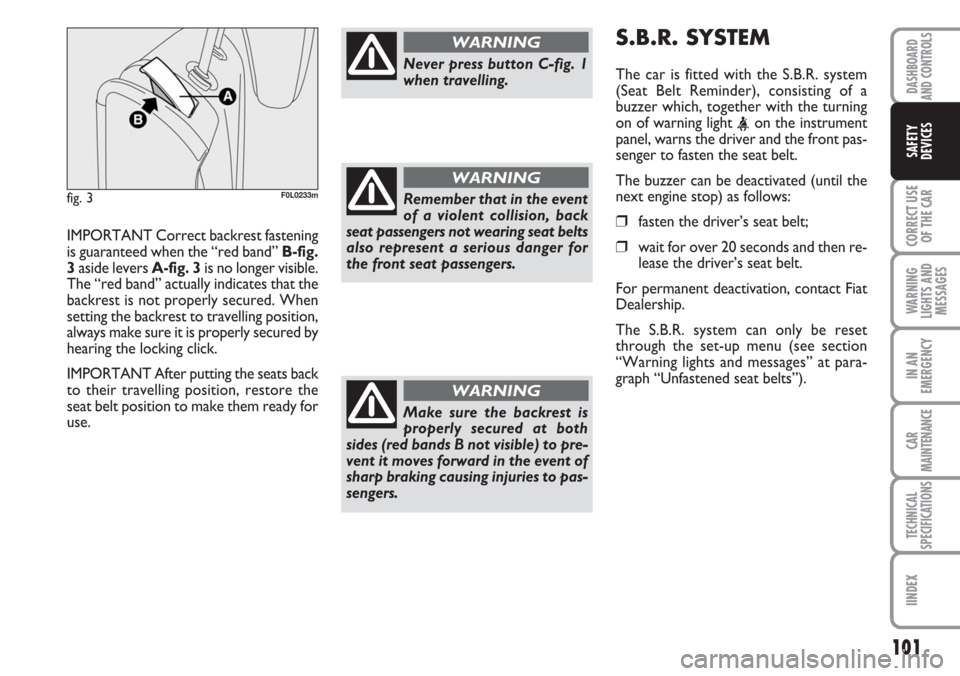
101
CORRECT USE
OF THE CAR
WARNING
LIGHTS AND
MESSAGES
IN AN
EMERGENCY
CAR
MAINTENANCE
TECHNICAL
SPECIFICATIONS
IINDEX
DASHBOARD
AND CONTROLS
SAFETY
DEVICES
IMPORTANT Correct backrest fastening
is guaranteed when the “red band” B-fig.
3aside levers A-fig. 3is no longer visible.
The “red band” actually indicates that the
backrest is not properly secured. When
setting the backrest to travelling position,
always make sure it is properly secured by
hearing the locking click.
IMPORTANT After putting the seats back
to their travelling position, restore the
seat belt position to make them ready for
use.
S.B.R. SYSTEM
The car is fitted with the S.B.R. system
(Seat Belt Reminder), consisting of a
buzzer which, together with the turning
on of warning light
senger to fasten the seat belt.
The buzzer can be deactivated (until the
next engine stop) as follows:
❒fasten the driver’s seat belt;
❒wait for over 20 seconds and then re-
lease the driver’s seat belt.
For permanent deactivation, contact Fiat
Dealership.
The S.B.R. system can only be reset
through the set-up menu (see section
“Warning lights and messages” at para-
graph “Unfastened seat belts”).
fig. 3F0L0233m
Never press button C-fig. 1
when travelling.
WARNING
Remember that in the event
of a violent collision, back
seat passengers not wearing seat belts
also represent a serious danger for
the front seat passengers.
WARNING
Make sure the backrest is
properly secured at both
sides (red bands B not visible) to pre-
vent it moves forward in the event of
sharp braking causing injuries to pas-
sengers.
WARNING
Page 102 of 240
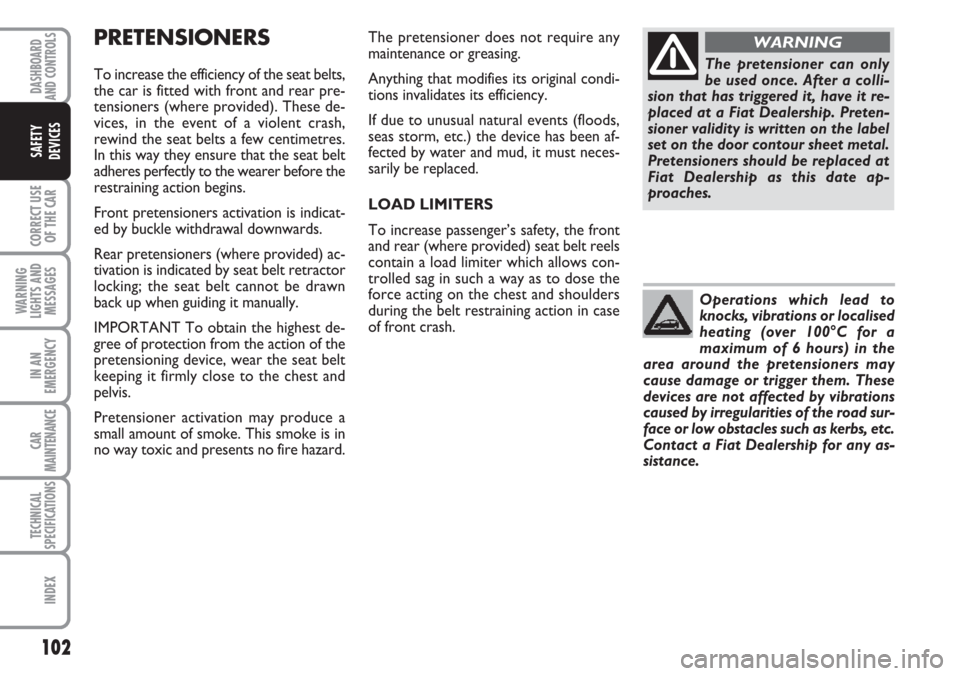
102
CORRECT USE
OF THE CAR
WARNING
LIGHTS AND
MESSAGES
IN AN
EMERGENCY
CAR
MAINTENANCE
TECHNICAL
SPECIFICATIONS
INDEX
DASHBOARD
AND CONTROLS
SAFETY
DEVICES
PRETENSIONERS
To increase the efficiency of the seat belts,
the car is fitted with front and rear pre-
tensioners (where provided). These de-
vices, in the event of a violent crash,
rewind the seat belts a few centimetres.
In this way they ensure that the seat belt
adheres perfectly to the wearer before the
restraining action begins.
Front pretensioners activation is indicat-
ed by buckle withdrawal downwards.
Rear pretensioners (where provided) ac-
tivation is indicated by seat belt retractor
locking; the seat belt cannot be drawn
back up when guiding it manually.
IMPORTANT To obtain the highest de-
gree of protection from the action of the
pretensioning device, wear the seat belt
keeping it firmly close to the chest and
pelvis.
Pretensioner activation may produce a
small amount of smoke. This smoke is in
no way toxic and presents no fire hazard.The pretensioner does not require any
maintenance or greasing.
Anything that modifies its original condi-
tions invalidates its efficiency.
If due to unusual natural events (floods,
seas storm, etc.) the device has been af-
fected by water and mud, it must neces-
sarily be replaced.
LOAD LIMITERS
To increase passenger’s safety, the front
and rear (where provided) seat belt reels
contain a load limiter which allows con-
trolled sag in such a way as to dose the
force acting on the chest and shoulders
during the belt restraining action in case
of front crash.The pretensioner can only
be used once. After a colli-
sion that has triggered it, have it re-
placed at a Fiat Dealership. Preten-
sioner validity is written on the label
set on the door contour sheet metal.
Pretensioners should be replaced at
Fiat Dealership as this date ap-
proaches.
WARNING
Operations which lead to
knocks, vibrations or localised
heating (over 100°C for a
maximum of 6 hours) in the
area around the pretensioners may
cause damage or trigger them. These
devices are not affected by vibrations
caused by irregularities of the road sur-
face or low obstacles such as kerbs, etc.
Contact a Fiat Dealership for any as-
sistance.
Page 103 of 240
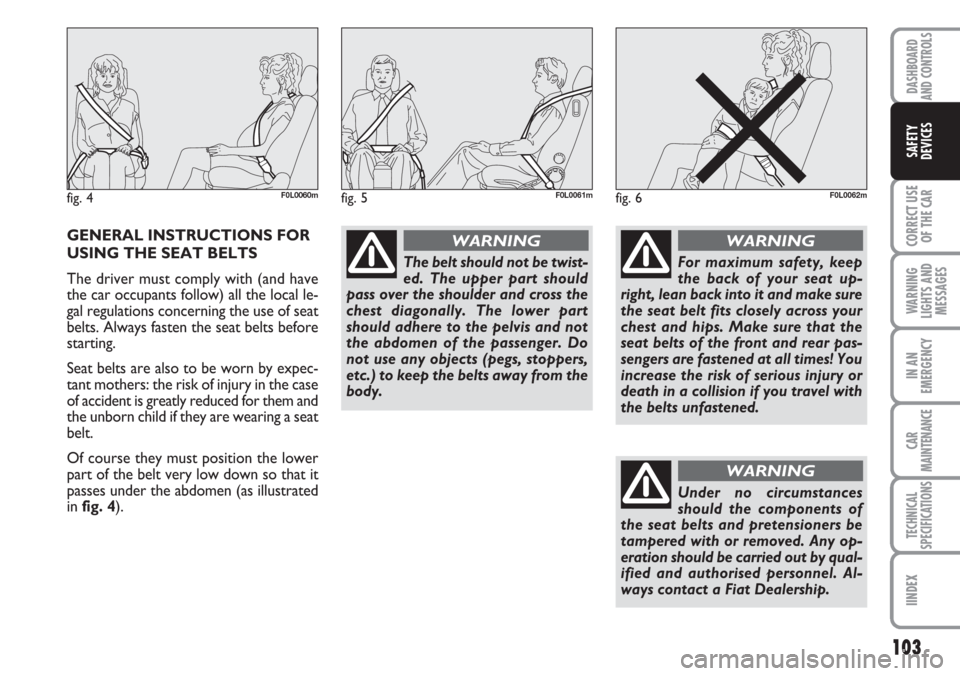
103
CORRECT USE
OF THE CAR
WARNING
LIGHTS AND
MESSAGES
IN AN
EMERGENCY
CAR
MAINTENANCE
TECHNICAL
SPECIFICATIONS
IINDEX
DASHBOARD
AND CONTROLS
SAFETY
DEVICES
GENERAL INSTRUCTIONS FOR
USING THE SEAT BELTS
The driver must comply with (and have
the car occupants follow) all the local le-
gal regulations concerning the use of seat
belts. Always fasten the seat belts before
starting.
Seat belts are also to be worn by expec-
tant mothers: the risk of injury in the case
of accident is greatly reduced for them and
the unborn child if they are wearing a seat
belt.
Of course they must position the lower
part of the belt very low down so that it
passes under the abdomen (as illustrated
in fig. 4).
fig. 4F0L0060mfig. 5F0L0061mfig. 6F0L0062m
The belt should not be twist-
ed. The upper part should
pass over the shoulder and cross the
chest diagonally. The lower part
should adhere to the pelvis and not
the abdomen of the passenger. Do
not use any objects (pegs, stoppers,
etc.) to keep the belts away from the
body.
WARNING
For maximum safety, keep
the back of your seat up-
right, lean back into it and make sure
the seat belt fits closely across your
chest and hips. Make sure that the
seat belts of the front and rear pas-
sengers are fastened at all times! You
increase the risk of serious injury or
death in a collision if you travel with
the belts unfastened.
WARNING
Under no circumstances
should the components of
the seat belts and pretensioners be
tampered with or removed. Any op-
eration should be carried out by qual-
ified and authorised personnel. Al-
ways contact a Fiat Dealership.
WARNING
Page 104 of 240
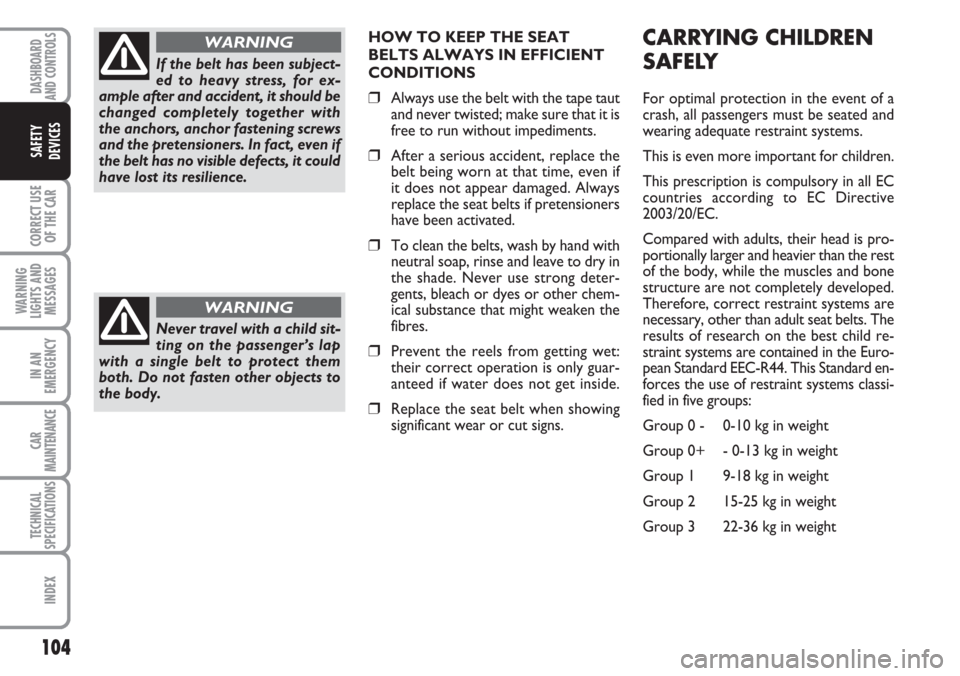
104
CORRECT USE
OF THE CAR
WARNING
LIGHTS AND
MESSAGES
IN AN
EMERGENCY
CAR
MAINTENANCE
TECHNICAL
SPECIFICATIONS
INDEX
DASHBOARD
AND CONTROLS
SAFETY
DEVICES
HOW TO KEEP THE SEAT
BELTS ALWAYS IN EFFICIENT
CONDITIONS
❒Always use the belt with the tape taut
and never twisted; make sure that it is
free to run without impediments.
❒After a serious accident, replace the
belt being worn at that time, even if
it does not appear damaged. Always
replace the seat belts if pretensioners
have been activated.
❒To clean the belts, wash by hand with
neutral soap, rinse and leave to dry in
the shade. Never use strong deter-
gents, bleach or dyes or other chem-
ical substance that might weaken the
fibres.
❒Prevent the reels from getting wet:
their correct operation is only guar-
anteed if water does not get inside.
❒Replace the seat belt when showing
significant wear or cut signs.
CARRYING CHILDREN
SAFELY
For optimal protection in the event of a
crash, all passengers must be seated and
wearing adequate restraint systems.
This is even more important for children.
This prescription is compulsory in all EC
countries according to EC Directive
2003/20/EC.
Compared with adults, their head is pro-
portionally larger and heavier than the rest
of the body, while the muscles and bone
structure are not completely developed.
Therefore, correct restraint systems are
necessary, other than adult seat belts. The
results of research on the best child re-
straint systems are contained in the Euro-
pean Standard EEC-R44. This Standard en-
forces the use of restraint systems classi-
fied in five groups:
Group 0 - 0-10 kg in weight
Group 0+ - 0-13 kg in weight
Group 1 9-18 kg in weight
Group 2 15-25 kg in weight
Group 3 22-36 kg in weight
If the belt has been subject-
ed to heavy stress, for ex-
ample after and accident, it should be
changed completely together with
the anchors, anchor fastening screws
and the pretensioners. In fact, even if
the belt has no visible defects, it could
have lost its resilience.
WARNING
Never travel with a child sit-
ting on the passenger’s lap
with a single belt to protect them
both. Do not fasten other objects to
the body.
WARNING
Page 105 of 240
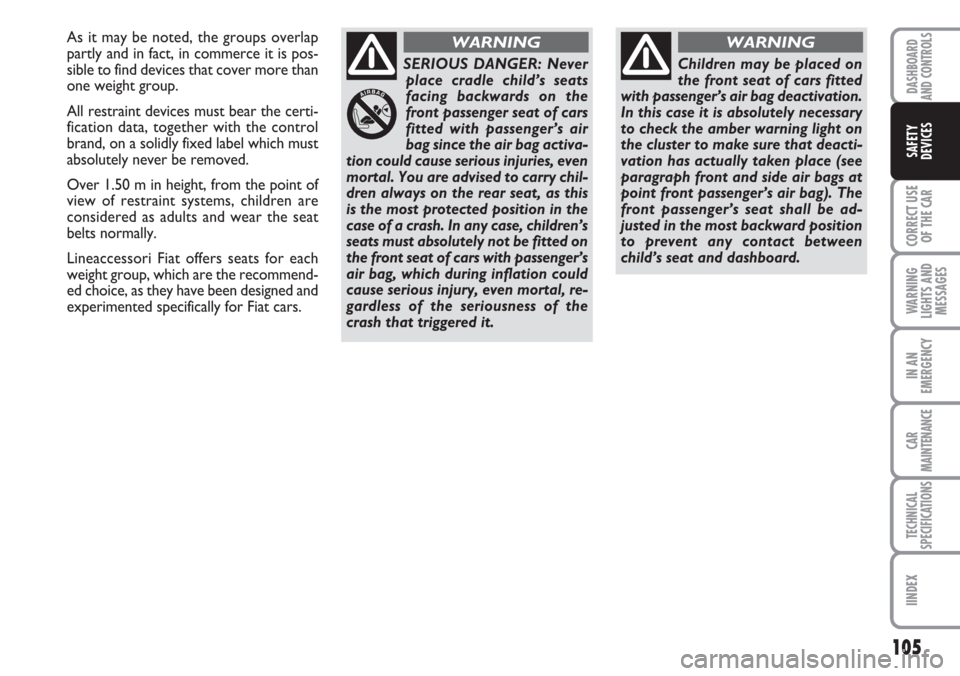
105
CORRECT USE
OF THE CAR
WARNING
LIGHTS AND
MESSAGES
IN AN
EMERGENCY
CAR
MAINTENANCE
TECHNICAL
SPECIFICATIONS
IINDEX
DASHBOARD
AND CONTROLS
SAFETY
DEVICES
As it may be noted, the groups overlap
partly and in fact, in commerce it is pos-
sible to find devices that cover more than
one weight group.
All restraint devices must bear the certi-
fication data, together with the control
brand, on a solidly fixed label which must
absolutely never be removed.
Over 1.50 m in height, from the point of
view of restraint systems, children are
considered as adults and wear the seat
belts normally.
Lineaccessori Fiat offers seats for each
weight group, which are the recommend-
ed choice, as they have been designed and
experimented specifically for Fiat cars.
SERIOUS DANGER: Never
place cradle child’s seats
facing backwards on the
front passenger seat of cars
fitted with passenger’s air
bag since the air bag activa-
tion could cause serious injuries, even
mortal. You are advised to carry chil-
dren always on the rear seat, as this
is the most protected position in the
case of a crash. In any case, children’s
seats must absolutely not be fitted on
the front seat of cars with passenger’s
air bag, which during inflation could
cause serious injury, even mortal, re-
gardless of the seriousness of the
crash that triggered it.
WARNING
Children may be placed on
the front seat of cars fitted
with passenger’s air bag deactivation.
In this case it is absolutely necessary
to check the amber warning light on
the cluster to make sure that deacti-
vation has actually taken place (see
paragraph front and side air bags at
point front passenger’s air bag). The
front passenger’s seat shall be ad-
justed in the most backward position
to prevent any contact between
child’s seat and dashboard.
WARNING
Page 106 of 240
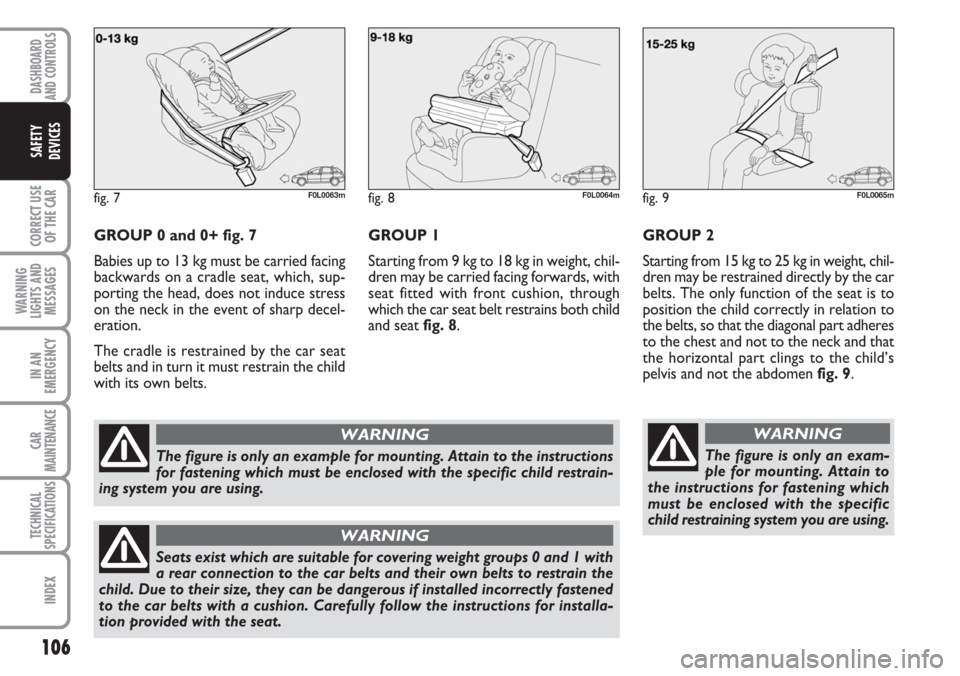
106
CORRECT USE
OF THE CAR
WARNING
LIGHTS AND
MESSAGES
IN AN
EMERGENCY
CAR
MAINTENANCE
TECHNICAL
SPECIFICATIONS
INDEX
DASHBOARD
AND CONTROLS
SAFETY
DEVICES
GROUP 0 and 0+ fig. 7
Babies up to 13 kg must be carried facing
backwards on a cradle seat, which, sup-
porting the head, does not induce stress
on the neck in the event of sharp decel-
eration.
The cradle is restrained by the car seat
belts and in turn it must restrain the child
with its own belts.GROUP 2
Starting from 15 kg to 25 kg in weight, chil-
dren may be restrained directly by the car
belts. The only function of the seat is to
position the child correctly in relation to
the belts, so that the diagonal part adheres
to the chest and not to the neck and that
the horizontal part clings to the child’s
pelvis and not the abdomen fig. 9.
fig. 7F0L0063m
The figure is only an example for mounting. Attain to the instructions
for fastening which must be enclosed with the specific child restrain-
ing system you are using.
WARNING
Seats exist which are suitable for covering weight groups 0 and 1 with
a rear connection to the car belts and their own belts to restrain the
child. Due to their size, they can be dangerous if installed incorrectly fastened
to the car belts with a cushion. Carefully follow the instructions for installa-
tion provided with the seat.
WARNING
fig. 8F0L0064m
GROUP 1
Starting from 9 kg to 18 kg in weight, chil-
dren may be carried facing forwards, with
seat fitted with front cushion, through
which the car seat belt restrains both child
and seat fig. 8.
fig. 9F0L0065m
The figure is only an exam-
ple for mounting. Attain to
the instructions for fastening which
must be enclosed with the specific
child restraining system you are using.
WARNING
Page 107 of 240
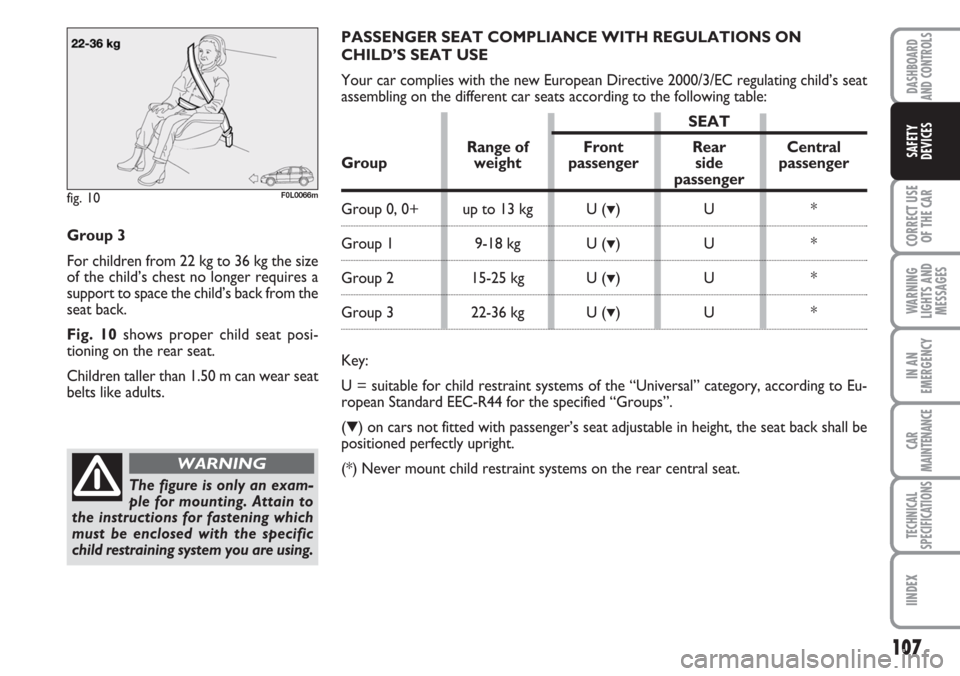
107
CORRECT USE
OF THE CAR
WARNING
LIGHTS AND
MESSAGES
IN AN
EMERGENCY
CAR
MAINTENANCE
TECHNICAL
SPECIFICATIONS
IINDEX
DASHBOARD
AND CONTROLS
SAFETY
DEVICES
Group 3
For children from 22 kg to 36 kg the size
of the child’s chest no longer requires a
support to space the child’s back from the
seat back.
Fig. 10shows proper child seat posi-
tioning on the rear seat.
Children taller than 1.50 m can wear seat
belts like adults.
fig. 10F0L0066m
The figure is only an exam-
ple for mounting. Attain to
the instructions for fastening which
must be enclosed with the specific
child restraining system you are using.
WARNING
PASSENGER SEAT COMPLIANCE WITH REGULATIONS ON
CHILD’S SEAT USE
Your car complies with the new European Directive 2000/3/EC regulating child’s seat
assembling on the different car seats according to the following table:
SEAT
Range of Front Rear Central
Group weight passenger side passenger
passenger
Group 0, 0+ up to 13 kg U (▼)U *
Group 1 9-18 kg U (▼)U *
Group 2 15-25 kg U (▼)U *
Group 3 22-36 kg U (▼)U *
Key:
U = suitable for child restraint systems of the “Universal” category, according to Eu-
ropean Standard EEC-R44 for the specified “Groups”.
(
▼) on cars not fitted with passenger’s seat adjustable in height, the seat back shall be
positioned perfectly upright.
(*) Never mount child restraint systems on the rear central seat.
Page 108 of 240
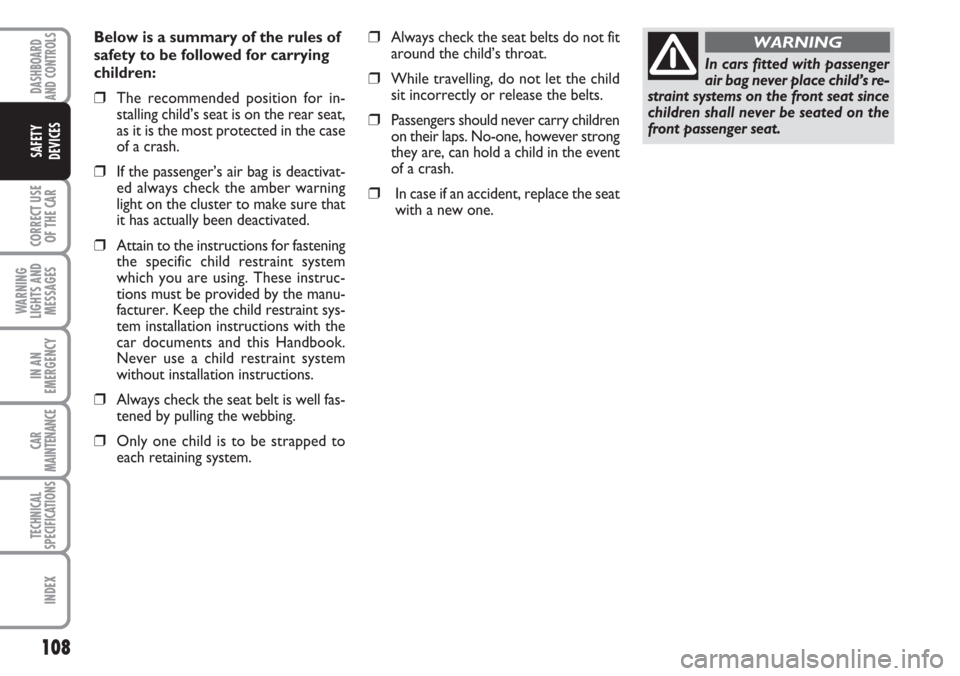
108
CORRECT USE
OF THE CAR
WARNING
LIGHTS AND
MESSAGES
IN AN
EMERGENCY
CAR
MAINTENANCE
TECHNICAL
SPECIFICATIONS
INDEX
DASHBOARD
AND CONTROLS
SAFETY
DEVICES
Below is a summary of the rules of
safety to be followed for carrying
children:
❒The recommended position for in-
stalling child’s seat is on the rear seat,
as it is the most protected in the case
of a crash.
❒If the passenger’s air bag is deactivat-
ed always check the amber warning
light on the cluster to make sure that
it has actually been deactivated.
❒Attain to the instructions for fastening
the specific child restraint system
which you are using. These instruc-
tions must be provided by the manu-
facturer. Keep the child restraint sys-
tem installation instructions with the
car documents and this Handbook.
Never use a child restraint system
without installation instructions.
❒Always check the seat belt is well fas-
tened by pulling the webbing.
❒Only one child is to be strapped to
each retaining system.
❒Always check the seat belts do not fit
around the child’s throat.
❒While travelling, do not let the child
sit incorrectly or release the belts.
❒Passengers should never carry children
on their laps. No-one, however strong
they are, can hold a child in the event
of a crash.
❒In case if an accident, replace the seat
with a new one.
In cars fitted with passenger
air bag never place child’s re-
straint systems on the front seat since
children shall never be seated on the
front passenger seat.
WARNING
Page 109 of 240
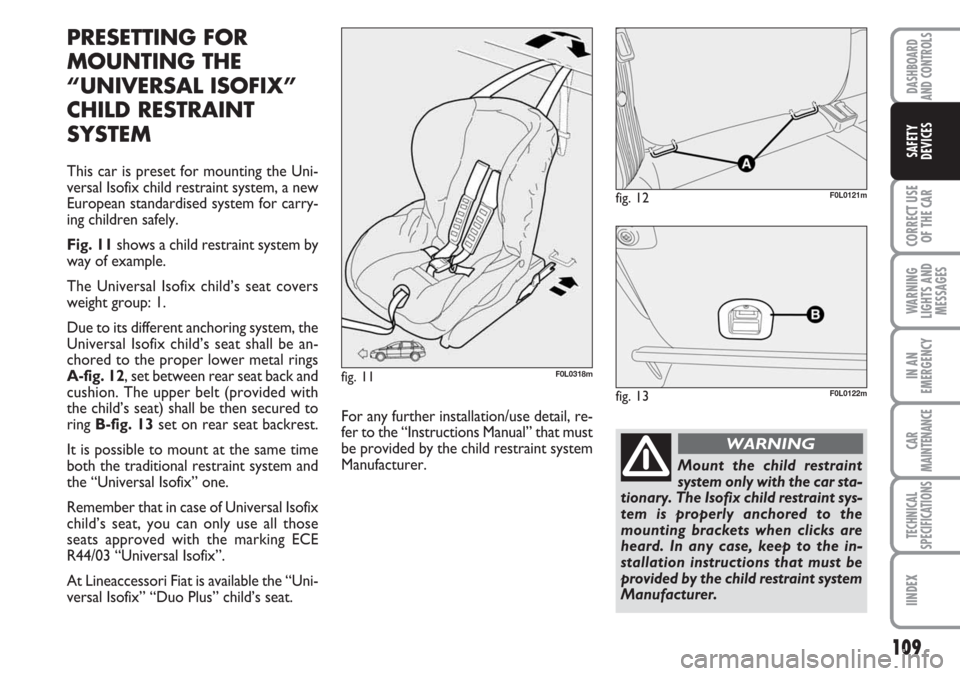
109
CORRECT USE
OF THE CAR
WARNING
LIGHTS AND
MESSAGES
IN AN
EMERGENCY
CAR
MAINTENANCE
TECHNICAL
SPECIFICATIONS
IINDEX
DASHBOARD
AND CONTROLS
SAFETY
DEVICES
PRESETTING FOR
MOUNTING THE
“UNIVERSAL ISOFIX”
CHILD RESTRAINT
SYSTEM
This car is preset for mounting the Uni-
versal Isofix child restraint system, a new
European standardised system for carry-
ing children safely.
Fig. 11shows a child restraint system by
way of example.
The Universal Isofix child’s seat covers
weight group: 1.
Due to its different anchoring system, the
Universal Isofix child’s seat shall be an-
chored to the proper lower metal rings
A-fig. 12, set between rear seat back and
cushion. The upper belt (provided with
the child’s seat) shall be then secured to
ring B-fig. 13set on rear seat backrest.
It is possible to mount at the same time
both the traditional restraint system and
the “Universal Isofix” one.
Remember that in case of Universal Isofix
child’s seat, you can only use all those
seats approved with the marking ECE
R44/03 “Universal Isofix”.
At Lineaccessori Fiat is available the “Uni-
versal Isofix” “Duo Plus” child’s seat.For any further installation/use detail, re-
fer to the “Instructions Manual” that must
be provided by the child restraint system
Manufacturer.
fig. 11F0L0318m
fig. 12F0L0121m
Mount the child restraint
system only with the car sta-
tionary. The Isofix child restraint sys-
tem is properly anchored to the
mounting brackets when clicks are
heard. In any case, keep to the in-
stallation instructions that must be
provided by the child restraint system
Manufacturer.
WARNING
fig. 13F0L0122m
Page 110 of 240

FRONT AND SIDE AIR
BAGS
The car is fitted with front air bags for the
driver, for the passenger and with driver’s
knees air bag (where provided).
The front driver / passenger air bags and
the driver’s knees air bag (where provid-
ed) have been designed to protect the oc-
cupants in the event of head-on crashes of
medium-high severity, by placing the cush-
ion between the occupant and the steer-
ing wheel or dashboard.
Front air bags are designed to protect
car’s occupants in front crashes and there-
fore non-activation in other types of col-
lisions (side collisions, rear shunts, roll-
overs, etc.) is not a system malfunction.
In case of crash, an electronic control unit,
when required, triggers the inflation of the
cushion. The cushion immediately inflates,
placing itself as a protection between the
body of the front occupants and the struc-
ture that could cause injuries. Immediate-
ly after, the cushion deflates.
The front driver / passenger air bags and
the driver’s knees air bag (where provid-
ed) are not a replacement of but comple-
mentary to the use of belts, which should
always be worn, as specified by law in Eu-
rope and most non European countries.
110
CORRECT USE
OF THE CAR
WARNING
LIGHTS AND
MESSAGES
IN AN
EMERGENCY
CAR
MAINTENANCE
TECHNICAL
SPECIFICATIONS
INDEX
DASHBOARD
AND CONTROLS
SAFETY
DEVICES
PASSENGER SEAT COMPLIANCE WITH REGULATIONS ON
UNIVERSAL ISOFIX CHILD’S SEAT USE
The table below, according to ECE 16 European Directive, shows the different instal-
lation possibilities of Universal Isofix restraint systems on seats fitted with Isofix fas-
teners.
Range of weight Child’s seat Isofix Isofix positionorientation class side rear
Group 0 to 10 kg
Group 0+ to 13 kg
Group I - 9
to 18 kg
IUF: suitable for Isofix child restraint systems to be set facing forwards, universal class
(fitted with third upper fastener), approved for the weight group.
IL: suitable for Isofix TYPE child restraint systems, specific and approved for this type
of car. The child’s seat can be installed by moving forward the front seat.
Facing backwards
Facing backwards
Facing backwards
Facing backwards
Facing backwards
Facing backwards
Facing forwards
Facing forwards
Facing forwardsE
E
D
C
D
C
B
B1
AIL
IL
IL
IL
IL
IL
IUF
IUF
IUF